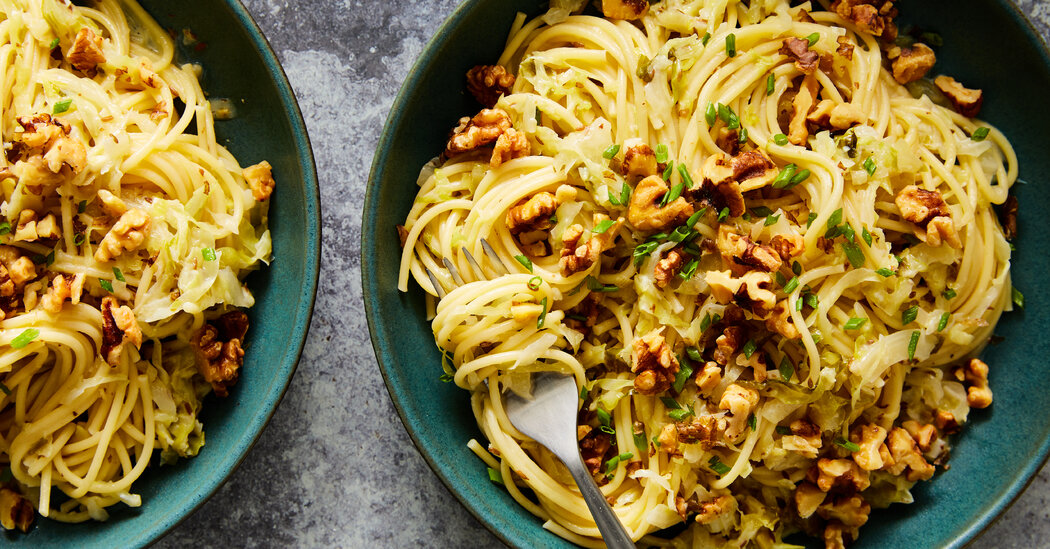
And inflation-friendly recipes for how to make the most of them once you have them.
Ten-dollar cartons of eggs. Seven-dollar gallons of milk. Two-dollar apples. Everyone — even Cardi B — is feeling the pain of jaw-droppingly high food costs driven by inflation and a flurry of other factors. And while, for the most part food prices stayed flat in February, consumers are still feeling the pinch — looking at you, eggs. It’s scary to see your grocery bill skyrocket, but while no one can predict what’s going to happen to food prices in the coming year, stocking up on certain ingredients when you spot them at a lower price can help you save significantly. We talked to a few budget experts and several New York Times editors and writers about what items they buy and how they make the most of them.
Before You Start
-
You may be new to budget shopping. If so, embrace grocery store circulars (you can use the Flipp app to track them). Make a list before you go, and if your grocery store has an online presence, compare prices.
-
Take a tip from Ali Slagle, a recipe developer and New York Times Cooking contributor, and stroll by your staple ingredients whenever you visit a store. You might discover a surprise sale.
-
Finally, the key to budget grocery shopping is being open to sacrificing convenience for a lower price. Consider visiting a couple of different stores to take advantage of sales. It can be worth it.
Dairy and Eggs
1. Cheese: Can you freeze hard cheeses like mozzarella and Cheddar? The answer is “yes” if you plan on melting it. (The thawed texture might be a bit weird for eating out of hand.) Krysten Chambrot, an associate editor for New York Times Cooking, chops up fresh mozzarella and freezes the slices on a sheet pan, then pops them into a resealable plastic bag for quick pizzas. “It keeps us from ordering in and keeps waste down for two people,” she said. Buy shredded cheese (or block cheese and shred it yourself) and freeze it.
Recipes: Pizza Margherita | The Original Nachos | Broccoli and Cheddar Soup
2. Butter: Genevieve Ko, a deputy editor for New York Times Cooking, freezes butter or, if she has the time, turns it into cookie or pie dough, or fully baked treats, and freezes them to enjoy later. (Keep an eye out for sales around major cooking holidays like Thanksgiving and Christmas.)
Recipes: Chocolate Chip Cookies | All-Purpose Biscuits | All-Butter Pie Crust
3. Milk: Natasha Janardan, a social video producer for New York Times Cooking, buys milk at a Brooklyn dollar store, where she can get a gallon for $4.19 instead of $7. Consider ditching dairy milk altogether if you don’t use a lot of it to begin with. These days, alternative milks are typically cheaper, and “a half gallon of oat milk lasts longer than whole dairy milk,” said Caroline Lange, a writer, recipe developer and tester in Brooklyn. You can also freeze milk. The consistency will change slightly, but it still works perfectly fine in baked goods. (The same goes for yogurt and buttermilk.)
4. Eggs: Don’t be afraid to buy a few cartons if you spot them at a good price. They keep for three to five weeks in the fridge (or longer). You can also freeze beaten eggs in ice cube trays, then pop the cubes into a resealable plastic bag to thaw for later use in baked goods or for scrambled eggs. Or, make a couple frittatas — or bake mini frittatas in muffin tins — and freeze them for busy mornings.
We are having trouble retrieving the article content.
Please enable JavaScript in your browser settings.
Thank you for your patience while we verify access. If you are in Reader mode please exit and log into your Times account, or subscribe for all of The Times.
Thank you for your patience while we verify access.
Already a subscriber? Log in.
Want all of The Times? Subscribe.
